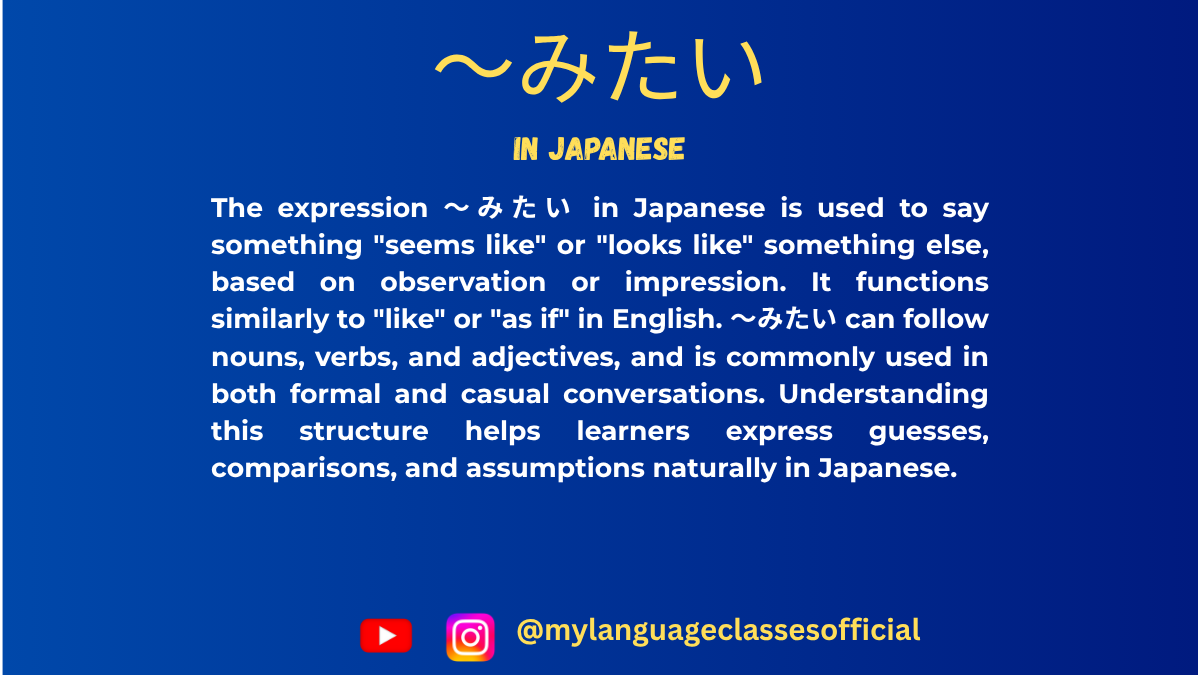Your cart is currently empty!
Understanding 〜みたい in Japanese

Expressing Resemblance and Conjecture in Japanese:〜みたい
When learning Japanese, understanding the nuanced use of grammatical structures can significantly improve your fluency. One such structure is 〜みたい. This versatile expression is commonly used in both casual and formal conversations to convey resemblance or conjecture. Let’s delve into the various ways 〜みたい is used and provide examples to solidify your understanding.
What is 〜みたい?
〜みたい is a colloquial expression that can be roughly translated as “like,” “seems like,” or “looks like.” It functions similarly to the formal grammatical structures 〜ようだ and 〜そうだ, but it is often used in casual speech.
Usage of 〜みたい
1. To Express Resemblance or Similarity
When you want to say something is similar to or resembles something else, you use 〜みたい after a noun.
- Structure:
Noun + みたい - Examples:
- 子供みたいに遊んでいる。
(Playing like a child.) - 雲が綿菓子みたいだ。
(The clouds look like cotton candy.)
- 子供みたいに遊んでいる。
2. To Indicate Conjecture Based on Observation
When you infer or guess something based on what you see, hear, or feel, 〜みたい can be used.
- Structure:
Verb (plain form) + みたい
Noun + みたい
Adjective (plain form) + みたい - Examples:
- 雨が降ったみたいだ。
(It seems like it rained.) - 彼は疲れているみたい。
(He seems tired.) - このケーキ、美味しいみたいだね。
(This cake seems delicious.)
- 雨が降ったみたいだ。
3. To Describe Hypothetical Situations or Figurative Comparisons
You can use 〜みたい to express something as if it were true, even though it isn’t.
- Structure:
Verb (plain form) + みたい
Noun + みたい - Examples:
- 夢みたいな話だ。
(It’s like a dream.) - あの二人は本当の兄弟みたいだ。
(Those two are like real brothers.)
- 夢みたいな話だ。
4. To Indicate Behavior or Action Similarity
You can describe someone acting like something or someone else using 〜みたい.
- Structure:
Verb (plain form) + みたい
Noun + みたい - Examples:
- 彼は猫みたいに静かに歩く。
(He walks quietly like a cat.) - 泣いているみたいに見える。
(It looks like they’re crying.)
- 彼は猫みたいに静かに歩く。
5. To Express Uncertainty or Doubt
When you are unsure about a situation, you can use 〜みたい to express your uncertainty.
- Structure:
Verb (plain form) + みたい
Noun + みたい - Examples:
- あの店、閉まっているみたいだ。
(It looks like that shop is closed.) - 試験は簡単みたいだけど、本当はどうかな?
(The test seems easy, but I wonder if it really is?)
- あの店、閉まっているみたいだ。
List of Situations Where 〜みたい is Used
- Comparing one object/person to another.
- Example: 彼女はお姫様みたいだ。 (She looks like a princess.)
- Guessing or making conjectures based on evidence.
- Example: 外は寒いみたいだ。 (It seems cold outside.)
- Making figurative or hypothetical comparisons.
- Example: 今日は地獄みたいに暑い。 (Today is as hot as hell.)
- Describing someone’s behavior or appearance.
- Example: 彼は大人みたいに振る舞う。 (He behaves like an adult.)
- Expressing uncertainty or hesitation.
- Example: あの人は誰か知っているみたいだけど、自信はない。 (It seems like they know that person, but I’m not sure.)
Key Points to Remember
- Casual Nature: 〜みたい is commonly used in informal settings. For more formal contexts, consider using 〜ようだ.
- Interchangeability: In some cases, 〜みたい, 〜ようだ, and 〜そうだ can be used interchangeably, but the nuance may differ slightly.
- Flexibility: It can follow nouns, verbs, and adjectives, making it highly versatile.
Practice Exercises
Try constructing sentences using 〜みたい for the following scenarios:
- Describe a situation where something resembles something else.
- Make a conjecture about something you just observed.
- Create a figurative comparison about an extreme weather condition.
By mastering 〜みたい, you’ll enhance your ability to express nuanced thoughts and interpretations in Japanese. Keep practicing, and soon it will become second nature in your conversations!
If you enjoyed this lesson, be sure to check out more posts like this on my blog at My Language Classes. Don’t forget to subscribe my YouTube channel and follow me on Instagram for the latest language learning tips and lessons. Leave a comment below to share your thoughts, or ask any questions you have about nouns.
Happy learning! 😊
📚 Continue Learning Japanese
Vikas Kumar is a dedicated language educator, content creator, and digital entrepreneur, best known as the co-founder of My Language Classes and The Curious Mind. With a strong focus on helping learners achieve fluency in English, Spanish, and Japanese, he has guided audiences worldwide through a diverse range of resources, including in-depth blog articles, engaging YouTube tutorials, and comprehensive Books.
Through My Language Classes, Vikas has built a thriving multilingual learning platform that serves students, travelers, and professionals eager to master communication skills for personal, academic, and professional success. His expertise extends to exam preparation for internationally recognized certifications such as JLPT, DELE, IELTS, and TOEFL, enabling learners to achieve tangible, career-enhancing results.
As the founder of The Curious Mind, he also explores broader areas of knowledge, including self-help, motivation, modern learning strategies, and thought-provoking insights on life and personal growth. His work blends practical teaching methods with a deep understanding of learner psychology, making complex concepts accessible and engaging.
Driven by a mission to make high-quality education accessible to all, Vikas continues to expand his reach across multiple platforms, including YouTube, blogs, eBooks, and social media communities, inspiring thousands to learn, grow, and embrace lifelong learning.


Leave a Reply